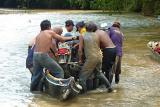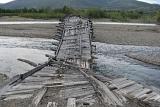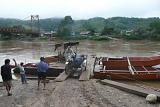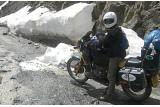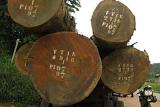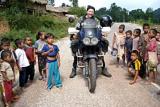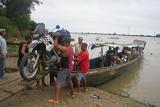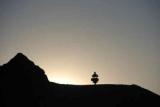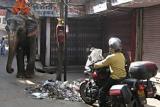-
"My heart sank when I saw what lay ahead. This little river was daunting to say the least. Huge trucks were crossing regularly, the water coming up to the tops of their wheels. The water level was as high as my saddle, and the current was fairly strong, the last thing I wanted was for the engine to stall and the bike to go over and get carried off by the river! There was a group of 8 or 9 Kuna men at the banks of the river, and after a little haggling, gesticulating and laughing, they agreed to lift the Harley into one of their canoes and walk it across the river to the other side. Gingerly, I rode the bike down the mud banks and in to the river until it was alongside the canoe that was barely as wide as the bike. With a few grunts and plenty of huffing and puffing, together we managed to lift the rear of the bike onto the canoe, and then hefted the front end in too..."
Daniel Shell, UK, in Colombia
-
"So off we go, getting darker as we start the 100 mile ride to the only reasonably sized village on this route. To kick things off, we're instantly confronted with a large wooden bridge that looks like it collapsed a long while back. I should be wiser after all the previous river crossings, instead I head straight in without first walking through to find a sensible route. It's deep, and more importantly, the current is strong, I'm lucky to make it to the far bank without incident. Simon isn't as lucky, falling in the deep water. We wrestle the overloaded KTM upright, and a Kamaz 6 wheel drive truck takes pity on us, leading a shallower route across the rest of the river. Again Simon falls in a deep section close to the bank. It can be hard work fighting against the current to right these heavy overland bikes."
Gabriel Bolton, UK, on the Road of Bones, Siberia
-
"We are in the middle of the drug growing area, but we don't have any problems. Everybody is just so surprised to see a sidecar, something they have never seen before. The Lonely Planet says this is a no go area, but we think that is wrong, we don't feel unsafe here at all, but the roads are in unbelievably bad condition, not able to transport back packers easily. Andy impresses me by riding the bike over a very small and damaged wooden bridge. He does that again when we have to take a ferry, which is made of two big canoes and planks. The tracks are still stony and if I was a banana I would have ended up as a milk shake..."
Andy Berwick and Maya Vermeer, in Peru
-
"Eventually the tunnel of terror loomed up before us, I had been pre-warned about this, it's an Iranian constructed four mile pitch-black flooded tunnel with deep potholes and a delightful carbon-monoxide atmosphere. At least it meant we didn't have to go all the way to the top of the mountain in the snow again. Within 50 yards we had lurched into a very deep pothole that soaked us and I almost dropped Thelma, I think it was only the thought of trying to pick up Thelma in 2 foot deep filthy water in the inky blackness that enabled me to desperately keep her upright..."
Tiffany Coates, UK, in Tajikistan
-
"The foliage alongside the road was dense. A six-inch earthen berm edged the right side of the piste, meaning no escape path. Suddenly, on the wrong side of the curve, aiming squarely at me, came a hard-cornering log truck. I slammed on both brakes. The front tire skidded on the gravelly piste and put my Suzuki down in an instant. I leapt off.
Prone on the triangulated sliver of piste between the truck's path and the edge of the road, I watched in slow-motion horror as a white Mercedes 3340 cab bore down upon me with the purposeful malice of a tank. I could see the malignant black tire on the driver's side churning inexorably towards me. The leering grille on the front of the cab. Its implacable silver Mercedes logo. The huge cloud of dust churned up by the truck's passage. The sound and the fury of the awful machine..."
Mark Hammond, USA, in Gabon
-
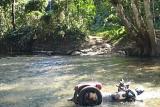
"The road soon turns into a dirt road. When I ask for the way at a national park toll gate people look at me strangely. I don't take the hint. I get to a fork in the road and make mistake number two: I choose one direction. A few metres further there is a farmer and I make mistake number three: instead of asking 'which way to Phu Joe?' I ask 'is this the way?' to which in Asia there is only one possible reply: Yes. Now the track is proper 4x4 stuff, going through a big mud hole, but without too much trouble. Then I face a major obstacle: a large ford. Now I make the final mistake: Not wanting to go back and the ford not looking too bad I try to cross. It turns out to be knee-deep with a decent current, holes and large boulders in the water. I get about to the middle until I drop the bike. The right pannier goes under and fills with water. I manage to get most of the other luggage off the bike more or less dry and get the bike up. A quick try confirms my worst fears: the starter can't turn the engine, full of water. It takes 4 people from a nearby village to push the bike back out, I pitch my tent for the night in the jungle..."
Peter Hendricks, Germany, in Malaysia
-
"From the first day on in Laos we're in love with this beautiful and so unspoiled country. During the stretch to Luang Namtha we encounter no more than 10 vehicles; we're passing through villages with bamboo houses on stilts, the children are screaming and waving at us and all kind of animals walking in herds along the new asphalt band. As soon as we stop, we're surrounded by curious kids, their parents observing us rather from a distance. With no electricity, no running water and no means of personal transportation, there must be a different definition of happiness in the mountains of northern Laos... we've seldom seen so many happy faces!"
Darius and Jane Skrzypiec, RTW, in Laos
-
"I woke up at 5:30 am, covered in ants, and felt very eager to leave the hotel. I packed my bags and arrived at the 'ferry terminal' at 6:30 am only to find out that the only operating ferry had already left. The other ferry was out of service. Instead, I was offered a place for my bike and myself on what looked like a big canoe. I wasn't at all happy about crossing the river in that thing, but the Colombians seemed like they knew what they were doing so I thought, why not. I found a seat in the canoe and managed to convince myself that this was a good idea. I was actually beginning to look forward to this little adventure but the joyful anticipation disappeared rather quickly when I realised that they kept letting passengers and motorcycles onto the canoe until we were 60 passengers, 10 motorcycles, and a lot of luggage. When the canoe left the dock, several passengers were shouting 'There's too much weight!' but nobody in charge of the boat listened..."
Annette Birkmann, Denmark, in Colombia
-
"With 20 liters of extra fuel in water jugs, some pasta and water we set off to Bolivia. What we should have also taken with us was a new battery, since mine failed and we had to push start the bike every time we stopped. At about 15,000 ft the cold wind picked up and the sandy, dusty, rutted road started, we both had some serious swerves and almost fell off in the first hundred feet. Than we got the hang of it more or less and made it to some beautiful hot springs. It was definitely the worst road I have ridden and it really took it out of me, standing up most of the way in fear. The three ladies were very sweet and laid out some 16 blankets on the floor for us to sleep under, gave us coca leaves to chew on to keep the altitude headaches away, and cooked us some food. All the tours finally left around 5 and we had the hot springs all to ourselves, with the longest shooting star we had ever seen."
Brad and Jolanta Glabek, USA, in Bolivia
-
"I was really surprised by the good roads in Iran and above all of the kindness and friendliness of its population. The mosques of Esfahan were the most beautiful of the trip and Persepolis sent me back to the ancient Persian times. The bazaars in Baluchistan Quetta were a real human zoo, full of Pashtuns, Afghans, and Baluchies with their daring glances and turbans. The Karakoram Highway in north Pakistan gave the best glimpses of some of the highest snowy mountains of the Himalayas. I finally reached India after five months and 20000 kms of roads. The highlight of my journey has been the unbelievable Leh-Manali road in Ladakh. No doubt, the most beautiful road in the world riding a motorbike. The astonishing almost moon landscape, at more than 4000 m altitude, of the Himalayan chain with the highest pass of the world at 5600 m. The craziness of Delhi's traffic and the Rajput palaces of Rajasthan and some elephants and holy cows to be avoided all the way on the messy roads of India."
Pablo Alvarez, Spain, in Iran, Pakistan and India





















